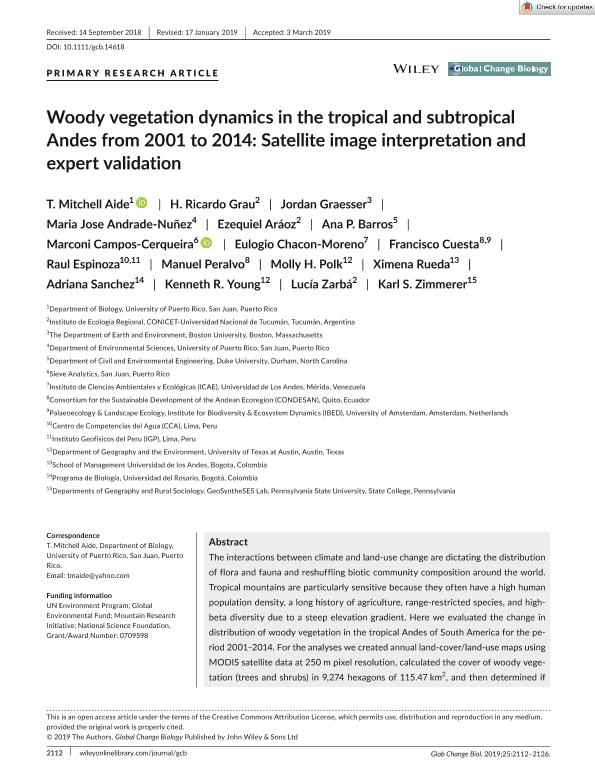Mostrar el registro sencillo del ítem
dc.contributor.author
Aide, T. Mitchell
dc.contributor.author
Grau, Hector Ricardo

dc.contributor.author
Graesser, Jordan
dc.contributor.author
Andrade Nuñez, Maria Jose
dc.contributor.author
Aráoz, Ezequiel

dc.contributor.author
Barros, Ana

dc.contributor.author
Campos Cerqueira, Marconi
dc.contributor.author
Chacon-Moreno, Eulogio
dc.contributor.author
Cuesta, Francisco
dc.contributor.author
Espinoza, Raúl
dc.contributor.author
Peralvo, Manuel
dc.contributor.author
Polk, Molly H.
dc.contributor.author
Rueda, Ximena
dc.contributor.author
Sanchez, Adriana
dc.contributor.author
Young, Kenneth R.
dc.contributor.author
Zarbá, Lucía

dc.contributor.author
Zimmerer, Karl S.
dc.date.available
2021-12-07T14:06:17Z
dc.date.issued
2019-06
dc.identifier.citation
Aide, T. Mitchell; Grau, Hector Ricardo; Graesser, Jordan; Andrade Nuñez, Maria Jose; Aráoz, Ezequiel; et al.; Woody vegetation dynamics in the tropical and subtropical Andes from 2001 to 2014: Satellite image interpretation and expert validation; Wiley Blackwell Publishing, Inc; Global Change Biology; 25; 6; 6-2019; 2112-2126
dc.identifier.issn
1354-1013
dc.identifier.uri
http://hdl.handle.net/11336/148374
dc.description.abstract
The interactions between climate and land-use change are dictating the distribution of flora and fauna and reshuffling biotic community composition around the world. Tropical mountains are particularly sensitive because they often have a high human population density, a long history of agriculture, range-restricted species, and high-beta diversity due to a steep elevation gradient. Here we evaluated the change in distribution of woody vegetation in the tropical Andes of South America for the period 2001–2014. For the analyses we created annual land-cover/land-use maps using MODIS satellite data at 250 m pixel resolution, calculated the cover of woody vegetation (trees and shrubs) in 9,274 hexagons of 115.47 km 2 , and then determined if there was a statistically significant (p < 0.05) 14 year linear trend (positive—forest gain, negative—forest loss) within each hexagon. Of the 1,308 hexagons with significant trends, 36.6% (n = 479) lost forests and 63.4% (n = 829) gained forests. We estimated an overall net gain of ~500,000 ha in woody vegetation. Forest loss dominated the 1,000–1,499 m elevation zone and forest gain dominated above 1,500 m. The most important transitions were forest loss at lower elevations for pastures and croplands, forest gain in abandoned pastures and cropland in mid-elevation areas, and shrub encroachment into highland grasslands. Expert validation confirmed the observed trends, but some areas of apparent forest gain were associated with new shade coffee, pine, or eucalypt plantations. In addition, after controlling for elevation and country, forest gain was associated with a decline in the rural population. Although we document an overall gain in forest cover, the recent reversal of forest gains in Colombia demonstrates that these coupled natural-human systems are highly dynamic and there is an urgent need of a regional real-time land-use, biodiversity, and ecosystem services monitoring network.
dc.format
application/pdf
dc.language.iso
eng
dc.publisher
Wiley Blackwell Publishing, Inc

dc.rights
info:eu-repo/semantics/openAccess
dc.rights.uri
https://creativecommons.org/licenses/by/2.5/ar/
dc.subject
AGRICULTURE
dc.subject
COUPLED NATURAL HUMAN SYSTEMS
dc.subject
EXPERT VALIDATION
dc.subject
FOREST LOSS AND REGENERATION
dc.subject
MODIS SATELLITE IMAGERY
dc.subject.classification
Otras Ciencias de la Tierra y relacionadas con el Medio Ambiente

dc.subject.classification
Ciencias de la Tierra y relacionadas con el Medio Ambiente

dc.subject.classification
CIENCIAS NATURALES Y EXACTAS

dc.title
Woody vegetation dynamics in the tropical and subtropical Andes from 2001 to 2014: Satellite image interpretation and expert validation
dc.type
info:eu-repo/semantics/article
dc.type
info:ar-repo/semantics/artículo
dc.type
info:eu-repo/semantics/publishedVersion
dc.date.updated
2020-11-20T18:11:03Z
dc.identifier.eissn
1365-2486
dc.journal.volume
25
dc.journal.number
6
dc.journal.pagination
2112-2126
dc.journal.pais
Reino Unido

dc.journal.ciudad
Londres
dc.description.fil
Fil: Aide, T. Mitchell. Universidad de Puerto Rico; Puerto Rico
dc.description.fil
Fil: Grau, Hector Ricardo. Universidad Nacional de Tucumán. Instituto de Ecología Regional. Consejo Nacional de Investigaciones Científicas y Técnicas. Centro Científico Tecnológico Conicet - Tucumán. Instituto de Ecología Regional; Argentina
dc.description.fil
Fil: Graesser, Jordan. Boston University; Estados Unidos
dc.description.fil
Fil: Andrade Nuñez, Maria Jose. Universidad de Puerto Rico; Puerto Rico
dc.description.fil
Fil: Aráoz, Ezequiel. Universidad Nacional de Tucumán. Instituto de Ecología Regional. Consejo Nacional de Investigaciones Científicas y Técnicas. Centro Científico Tecnológico Conicet - Tucumán. Instituto de Ecología Regional; Argentina
dc.description.fil
Fil: Barros, Ana. University of Duke; Estados Unidos
dc.description.fil
Fil: Campos Cerqueira, Marconi. Sieve Analytics Inc.; Puerto Rico
dc.description.fil
Fil: Chacon-Moreno, Eulogio. Universidad de Los Andes; Venezuela
dc.description.fil
Fil: Cuesta, Francisco. Consortium for the Sustainable Development of the Andean Ecoregion; Ecuador. University of Amsterdam; Países Bajos
dc.description.fil
Fil: Espinoza, Raúl. Instituto Geofísico del Perú; Perú. Centro de Competencias del Agua; Perú
dc.description.fil
Fil: Peralvo, Manuel. Consortium for the Sustainable Development of the Andean Ecoregion; Ecuador
dc.description.fil
Fil: Polk, Molly H.. University of Texas at Austin; Estados Unidos
dc.description.fil
Fil: Rueda, Ximena. Universidad de los Andes; Colombia
dc.description.fil
Fil: Sanchez, Adriana. Universidad Colegio Mayor de Nuestra Señora del Rosario; Colombia
dc.description.fil
Fil: Young, Kenneth R.. University of Texas at Austin; Estados Unidos
dc.description.fil
Fil: Zarbá, Lucía. Universidad Nacional de Tucumán. Instituto de Ecología Regional. Consejo Nacional de Investigaciones Científicas y Técnicas. Centro Científico Tecnológico Conicet - Tucumán. Instituto de Ecología Regional; Argentina
dc.description.fil
Fil: Zimmerer, Karl S.. State University of Pennsylvania; Estados Unidos
dc.journal.title
Global Change Biology

dc.relation.alternativeid
info:eu-repo/semantics/altIdentifier/doi/http://dx.doi.org/10.1111/gcb.14618
dc.relation.alternativeid
info:eu-repo/semantics/altIdentifier/url/https://onlinelibrary.wiley.com/doi/full/10.1111/gcb.14618
Archivos asociados
